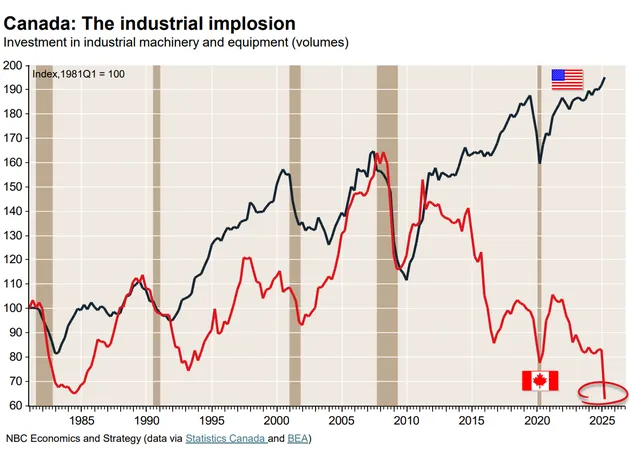
Canada's Industrial Crisis: How It Fell Behind the U.S.
2025-09-12
Author: Benjamin
In a startling revelation, recent data shows that Canada's investment in industrial machinery and equipment has plummeted to record lows, while the United States continues to thrive. This surprising divergence is laid bare by analysts Stéfane Marion and Matthieu Arseneau from the National Bank of Canada, who describe the situation as "appalling."
Their insights reveal that Canada’s investment dropped to its lowest point since 1981 in the second quarter, highlighting an alarming trend where years of excessive regulation and a lack of proactive government support have stymied industrial growth. This is in stark contrast to the U.S., where investments have remained stable and on track.
The analysts emphasized that the roots of this industrial failure are deep. They pointed to a chronic ambivalence from Canadian governments over the years concerning the development of domestic industries and resources, compounded by protectionist measures from Washington.
Stéfane Marion and Matthieu Arseneau further noted that unless Canada acts swiftly, it risks falling behind in global supply chains and eroding its manufacturing base. While the Canadian government's recent commitment to ramp up military spending—targeting 3.5% of GDP—offers a glimmer of hope for reindustrialization, the clock is ticking.
Experts are calling for a robust, multifaceted strategy akin to a wartime effort: competitive tax incentives, aggressive reduction of bureaucratic hurdles, and clear policies for natural resource development are essential for Canada’s industrial revival.
Moreover, it is ironic that while Canada has demonstrated an ability to invest in and create a housing market bubble that has endured through crises, it struggles to support its industrial backbone. The challenges ahead are clear, but with determined leadership reminiscent of Clarence Decatur Howe’s era of Canadian industrialization, there’s still time to rebuild before it’s too late.









 Brasil (PT)
Brasil (PT)
 Canada (EN)
Canada (EN)
 Chile (ES)
Chile (ES)
 Česko (CS)
Česko (CS)
 대한민국 (KO)
대한민국 (KO)
 España (ES)
España (ES)
 France (FR)
France (FR)
 Hong Kong (EN)
Hong Kong (EN)
 Italia (IT)
Italia (IT)
 日本 (JA)
日本 (JA)
 Magyarország (HU)
Magyarország (HU)
 Norge (NO)
Norge (NO)
 Polska (PL)
Polska (PL)
 Schweiz (DE)
Schweiz (DE)
 Singapore (EN)
Singapore (EN)
 Sverige (SV)
Sverige (SV)
 Suomi (FI)
Suomi (FI)
 Türkiye (TR)
Türkiye (TR)
 الإمارات العربية المتحدة (AR)
الإمارات العربية المتحدة (AR)